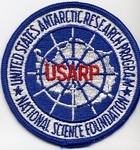|
 |
The expedition was part of the USARP, United States Antarctica Research Program. That’s the badge above. The 3 month expedition to Antarctica was the most difficult of all expeditions for him, not surprising given the brutal setting that no one handles with aplomb. In fact, it was so bad that he actually pulled the plug and returend home about a month early, something he never would have done otherwise. This stuck in his craw for years and I am not sure that he had ressolved the question when died, “Should I have stayed?” He didn’t discuss the topic with anyone, even his wife.
In communications with Tom Rich, Ph.D., another paleontologist who was also “on the ice”, it is evident that Jim struggled with a variety of things, and that his public representation of his rationale for leaving may not have jibed perfectly with his personal reasons. I neither wish, nor am I qualified, to judge what the “truth” is about the matter even with this manuscript in hand. Indeed, time has shown that there is really no such thing as ‘truth’, rather we each create our own and live with is. His account lays out his reasoning, which is persuasive, but may be hindsight. I will probably post his story on this website, but will omit the last segment that agonizes over the personal reasons, and conversations that he replayed.
I don’t know how this expedition was mounted. Dr. Ed Colbert, RIP, invited dad to participate on the expedition which was led by a Dr. Elliott from Ohio State University. Here’s one gallery, others will follow:
In anticipation of the terrible conditions, he decided that he would design equipment and collection methods to cope with them. His years in Alaska, when the climate was indeed harsh compared to the present climate, he learned a great deal about cold conditions. His efforts paid off in Antarctica. The two pieces of equipment that he developed were the following:
After he had his new equipment fabricated, he arranged a trip up on nearby Mount Timanogos in the wnter to test them. At ~12,000 feet in the winter, while the conditions were not as harsh as in Antarctica, they were the most harsh in close proximity. It turned out that this undertaking was more challenging to him in terms of organizational skills than the trip to Antarctica. He wrote another paper that detailed the operation, a paper half as long as his description of his 3 months on the expedition.
Timpanogos Paper - to be digitized
In the few years following his return, he was compelled to set down on paper his thoughts. He had kept a log of the trip of some sort and used that as the timeline for the manuscript. It would be possible with enough time and energy to create a document with appropriate slides to illustrate it, but that may not happen in this life. I intend, however, to digitize the manuscript and post it on this site. I will omit the last dozen pages, however. They are too personal to be listed, and I’m not sure they are actualy factual. Better to have his account stick to the objective information, the facts.
Antarctica Paper - to be digitized
He took many photos with a new Olympus camera purchased specifically for the job. He took his warm gloves to the camera store where he attempted to manipulate cameras to find the one that was easiest to handle. That’s how he arrived at the Olympus. He also bought a 16mm movie camera with his own money, the film with his own money, and the develoment with his own money, so that they would be his own product. I have had one of the movies digitized and Nathan had given me screen shots of a dozen or some images to show what’s on the movie. Several galleries will be prepared and located for viewing here:
|